Comparing Synthetic Watercolour Brushes – Part 5 (the final episode!)
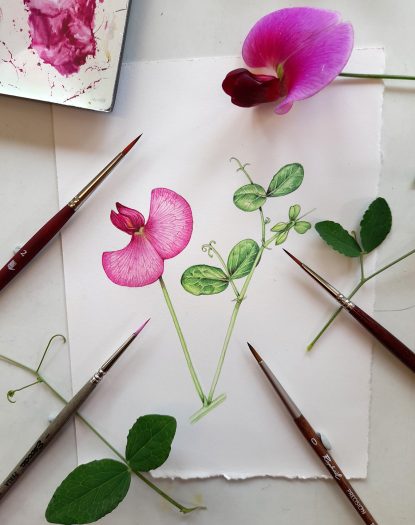
This is the fifth and final of my blogs and linked films, looking for a synthetic watercolour brush to replace the sable ones made by Winsor & Newton. My Winsor & Newton series 7 number 1 size is the brush I always use.
Today I’m reviewing the Escoda Prado Tame synthetic,Escoda Perla White Toray synthetic, Princeton Velvet touch range £4.67, and a number 0 from the Raphaël Set of 3 Sable Brushes Synthetic Travel #01 £10.05
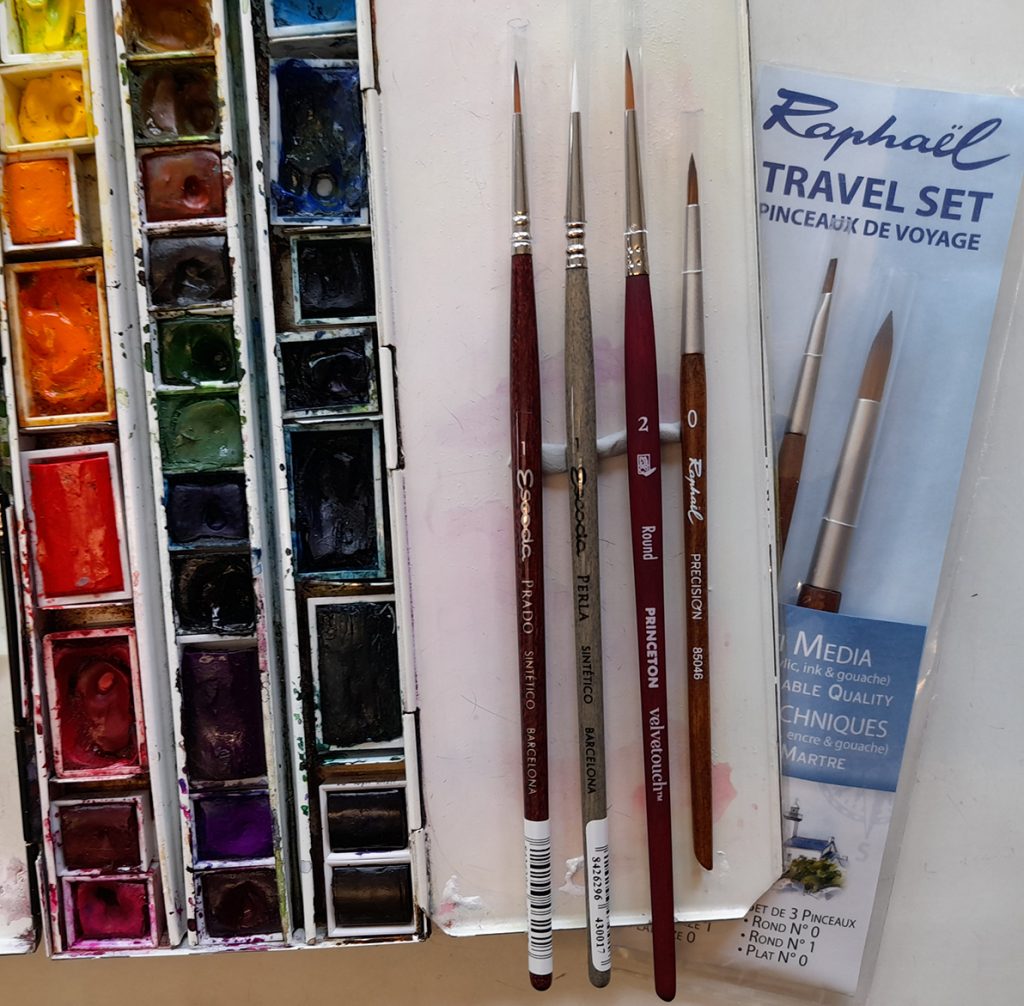
Brushes I’m testing today
Sable vs Synthetics – what are the concerns?
You may not be surprised to hear that this topic has occupied me, and every time I do another series of tests I return to the same question. Which is ethically worse, Sable or Synthetic? Sable brushes are cruel to animals. Synthetics are one-use plastics. I’m damned if I do and damned if I don’t.
Synthetics cost a lot less than my Series 7 brushes, a new No. 1 Series 7 brush an cost more than £25. Most of the synthetics I’m trialling cost under £10.
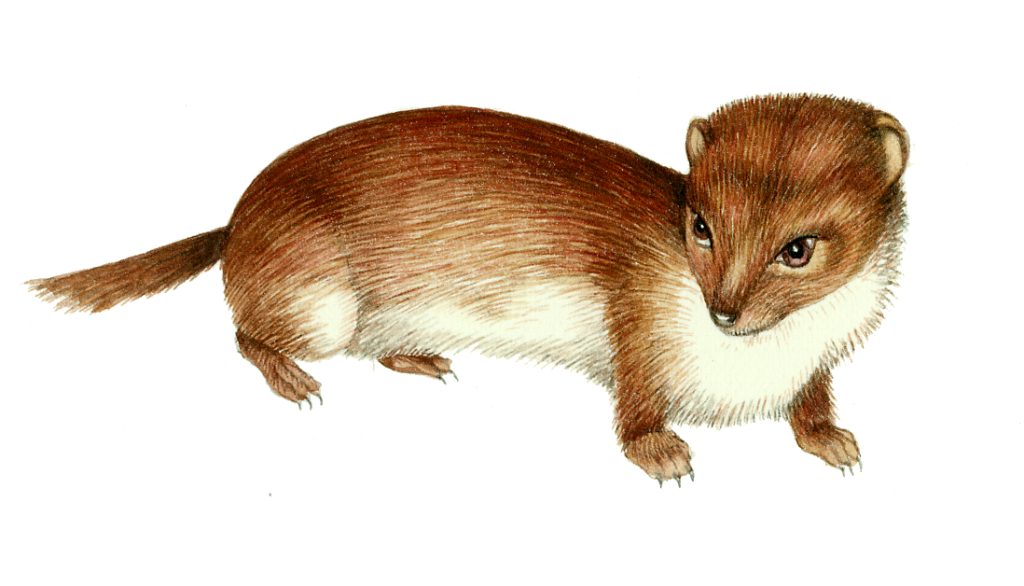
European Weasel Mustela nivalis (relative of M. sibirica)
The drawbacks of sable and squirrel brushes is that the Siberian weasel Mustela sibirica is hunted and killed for its’ paint-brush perfect tail hair. As a vegetarian, this feels really uncomfortable, somewhat akin to wearing fur (see PETA’s Why Buying an animal hair paintbrush is like wearing fur article.) In fact, there’s some suggestion Kolinisky sable brushes have been banned in the US since 2014 (Kolinsky Sable Brushes banned in the US Gurney Journey 2014), although I hadn’t heard of this before. Some believe the hair is a by-product (having been in touch with Winsor & Newton I can confirm this isn’t true, they’re hunted specifically for my brushes), others say reducing the Siberian weasel population is not bad thing as they prey on chickens, and the most surprising comment was this, on a MetaFilter discussion board): “And these weasels need killing, as they are infamous among the Chinese for stealing souls”. For more on this topic, there’s a heated discussion on he Dakka Dakka forum.
Synthetics wear down quickly, splay, and their tips hook. This is due to the material they’re made from and is inevitable. They are non-recyclable single-use plastics. They will go to landfill where they’ll stay for centuries.
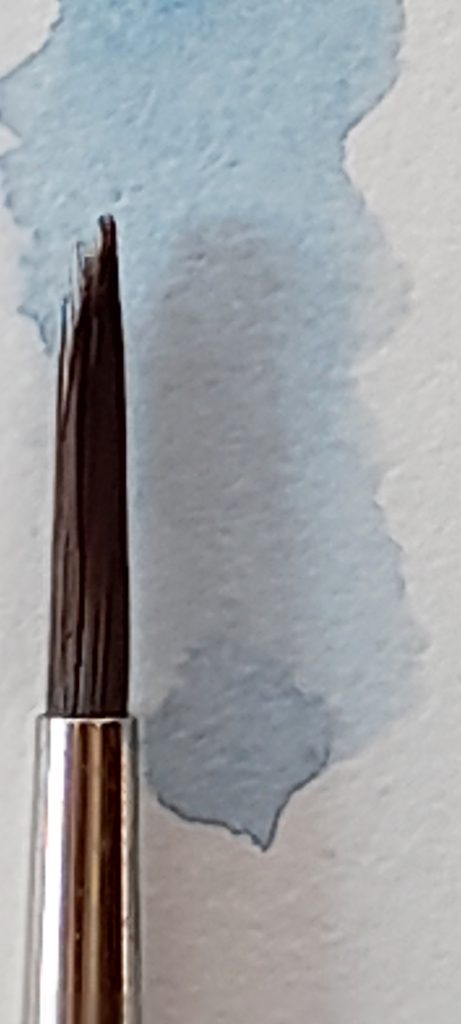
Tip of a Jackson’s Kite brush showing degredation that occurred within 15 minutes
Neither option is perfect, and there’s a part of me that’s thinking “Curses, let’s just stick with what I know as whatever I do I’m damaging the natural world. Maybe I need to learn how to paint with a small twig from a fallen branch. Sigh.”
But the best suggestion is to look after your equipment carefully and thus use less of it, no matter whether synthetic or sable. I’m training myself to mix with a separate brush and am showing my brushes more love and care than before.
However, for now it’s time to continue the quest.
Synthetic Brushes Tested so far…
I’ve worked my way through about 15 synthetic brushes, without stumbling on the Holy Grail of replacements. Of the ones I’ve tried (see below), my favourites to date are the Princeton Neptune round (a synthetic squirrel) and Rosemary & Company Red Dot Spotter, a synthetic sable. For fine detail, I was impressed by the Billie Showell Fineliner

All the brushes tested so far with todays contenders in the top right and my Winsor and Newton series 7 on show too
Film 1 (and blog) shows me trying out Winsor & Newton synthetic sable, Rosemary and Co. Spotter Red Dot, Princeton Aqua elite, and my one freebie – the ZenART fineline minature paintbrushes
In film and blog 2, Princeton Neptune script. Kite S561 by Jackson’s, Rosemary and Company Pointed Red Dot, Da Vinci Casaneo 5598 Round are under the spotlight.
Blog and film 3 saw me review Princeton Neptune round, Jackson’s Icon synthetic Quill S777 10/0, Escoda Versatil round, and Da Vinci Colineo.
In the fourth film I reviewed the Bille Showell’s fine liner, ProArte Masterstroke Series 60 Round, Rosemary & Company Designer Red Dot, and the Winsor & Newton Cotman 111 round
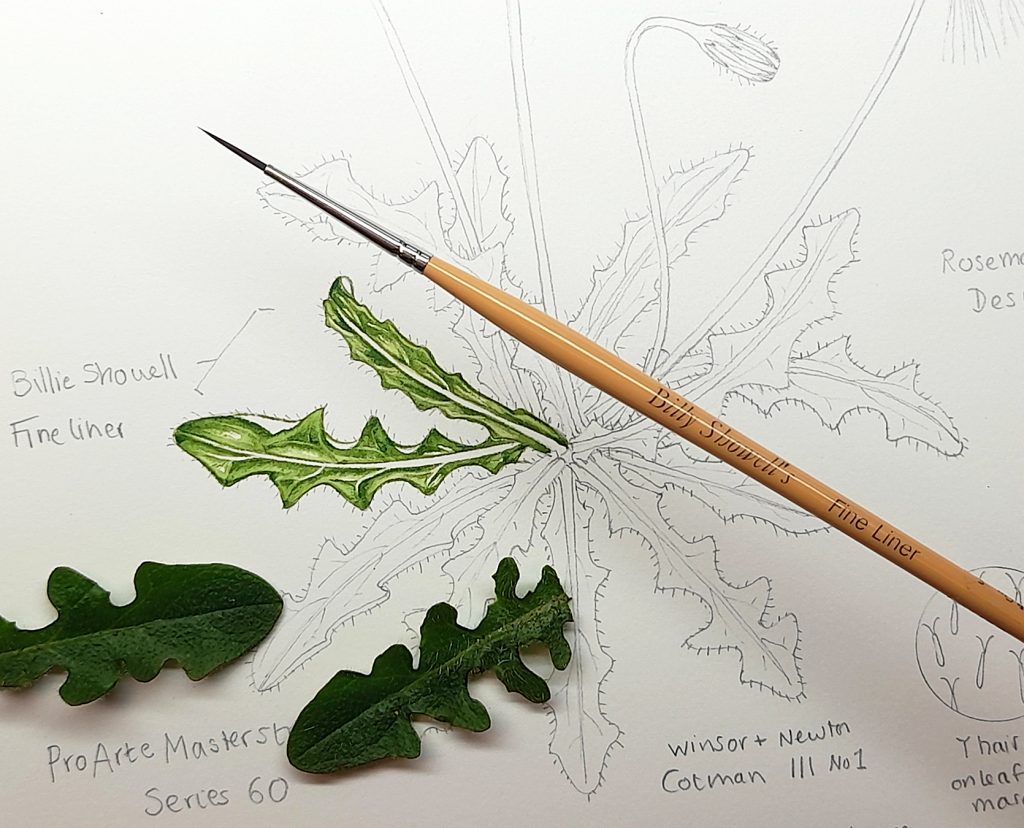
Billie Showell fineliner
Synthetic Brush reviews: Unsponsored and honest
I’ve paid for all the brushes I’ve tested which keeps things objective if pricey (bar one – ZenART fineline minature paintbrushes). I buy most from Jackson’s here in the UK because they carry a wide variety (they’re not sponsoring me either, although if they wanted to…?). They also have a great ecological policy when it comes to sending things through the post, minimal and using entirely recyclable packaging. Other art suppliers here in the UK I’d recommend include; Cass Art, Cowling and Wilcox, Ken Bromley, and London Graphic Centre spring to mind.
Of the brushes tested, only some of the Rosemary & Co range need to be purchased direct from their website, either online or by phone.
Any replacement I finally settle on will have to perform as well as my Series 7, and will have to overcome my long held affection for a brush which works so well for me.
All of these opinions and reviews are mine, and I know that brush choice can be very personal. Just because I rate or write off a brush is no guarantee that you’ll feel the same. I don’t want to preach or change the way people feel about brands they love, but hope some of this research may help others on a similar quest.
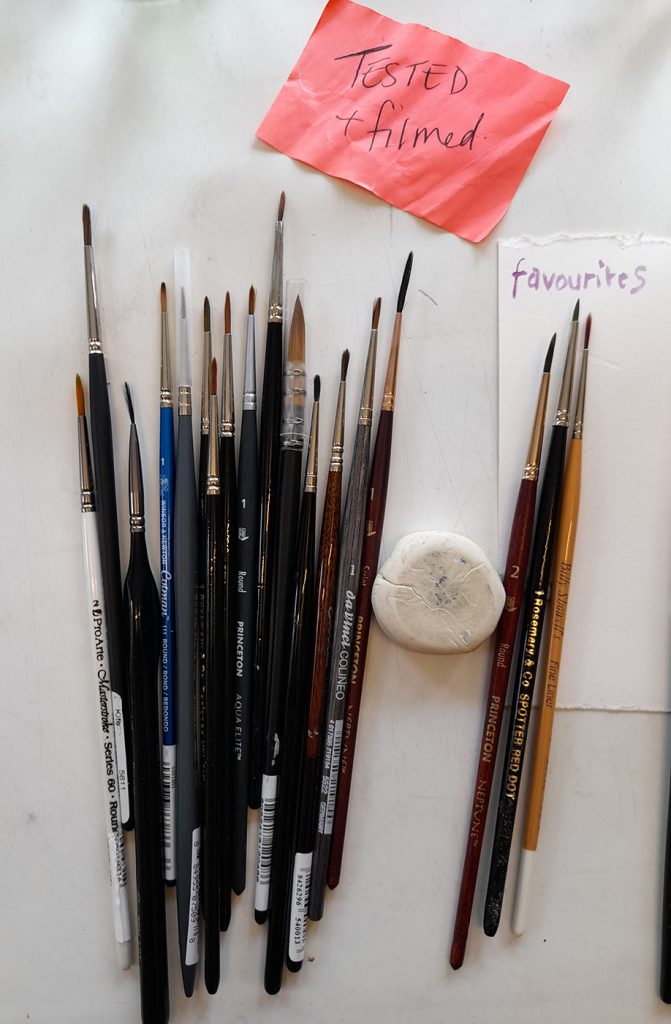
All the brushes tested up til today
Escoda Prado Tame synthetic
Escoda Prado Tame synthetic: The new brush
This is a number 1 brush, my preferred size. On first sight this is a good looking brush, with a sharp tip. The handle is the right length, and a high gloss brown. It hasn’t got a really long nib like some of the script brushes I’ve trialled.
Escoda Prado Tame synthetic: Mixing paint
I’ve tried NOT to be too vigorous mixing paint with this set of brushes as lots of people have said the reason why my brushes die so fast it because I beat them up in the mixing process.
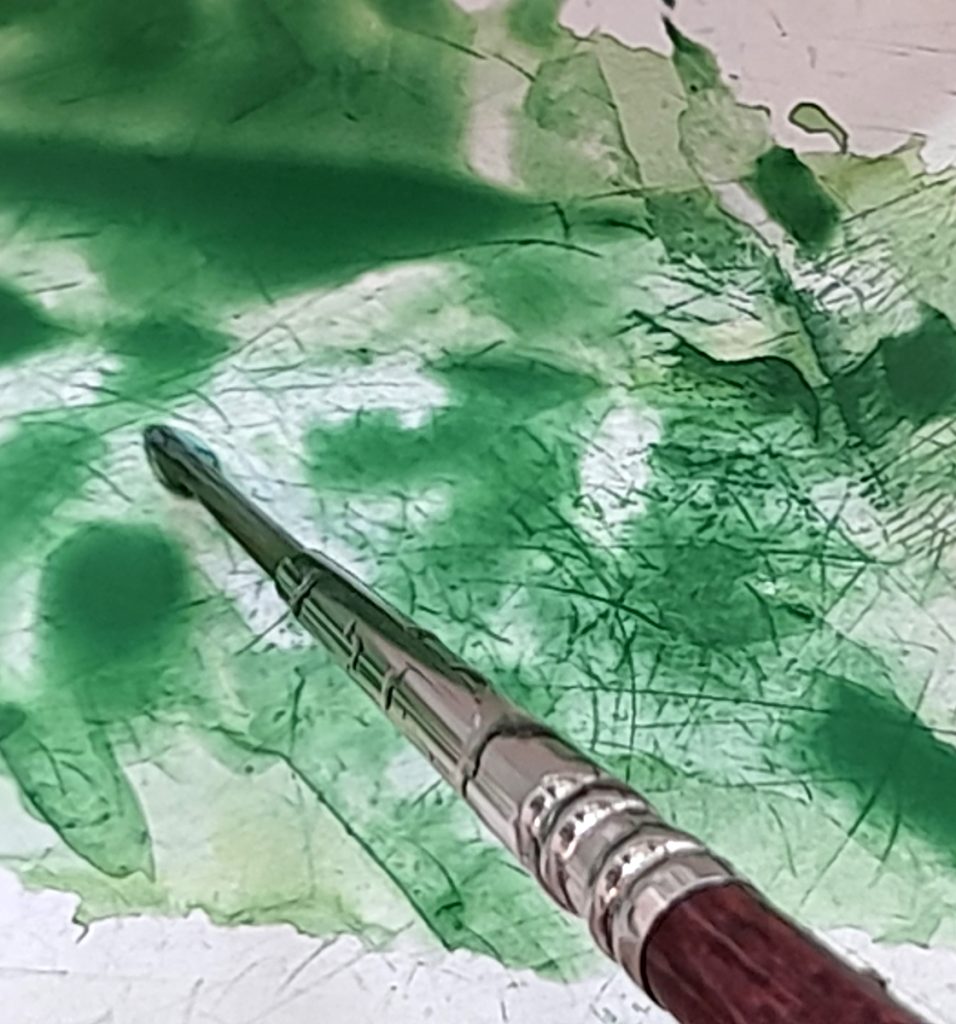
However, in terms of loading the brush and adding water, it’s good. A decent sized well carries plenty of paint, and the tip doesnt sply or lose clarity when wetted.
Escoda Prado Tame synthetic: How sharp is that point?
A good question, and the gratifying answer is, really, very. It has a really sharp tip which doesnt degrade over the time I paint with it. I’m hyper-sensitive to the slightest hook of a synthetic brush by now, and the Escoda Prado avoided hooking.
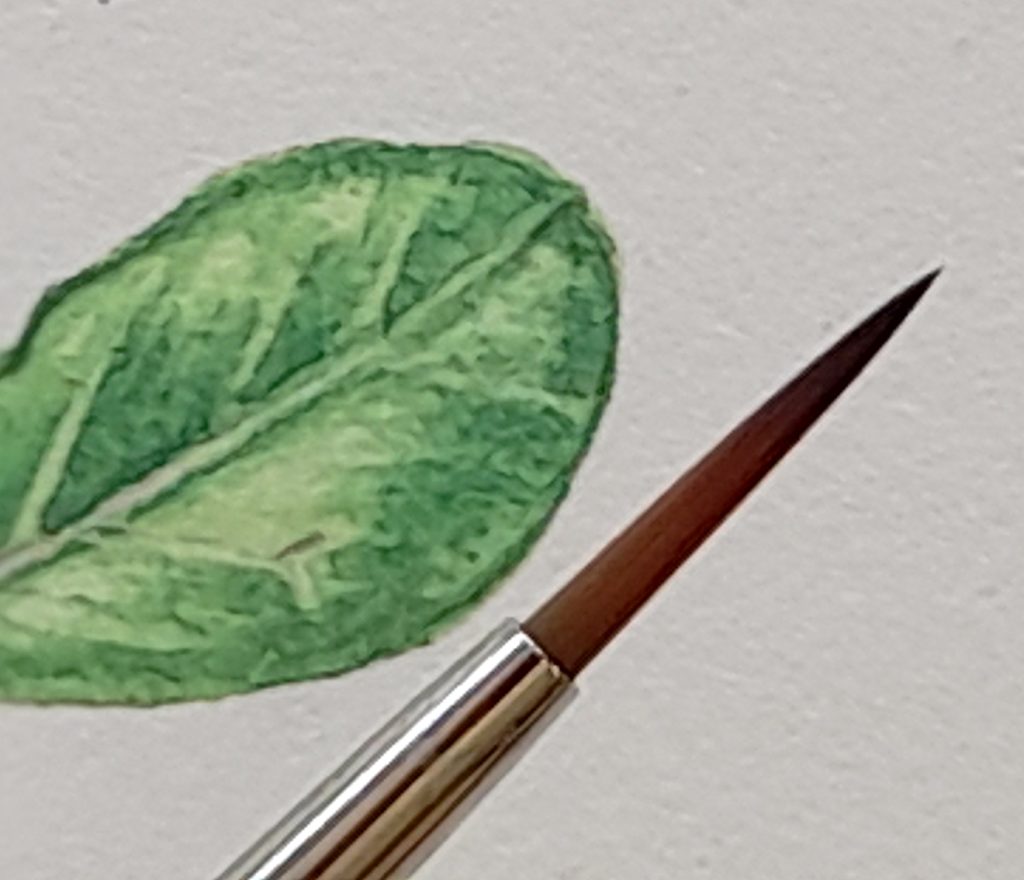
Painting with it was actually fine. Very similar to my current favourite, the Princeton Neptune round. The fibres feel a little softer, and although at this point in time it feels like I’m nit-picking, I would have liked them to have a bit more bite, spring, resistance. But then perhaps this is another of the “what you’re used to” issues; if I expect sable behaviour from a synthetic I’ll be forever disappointed.
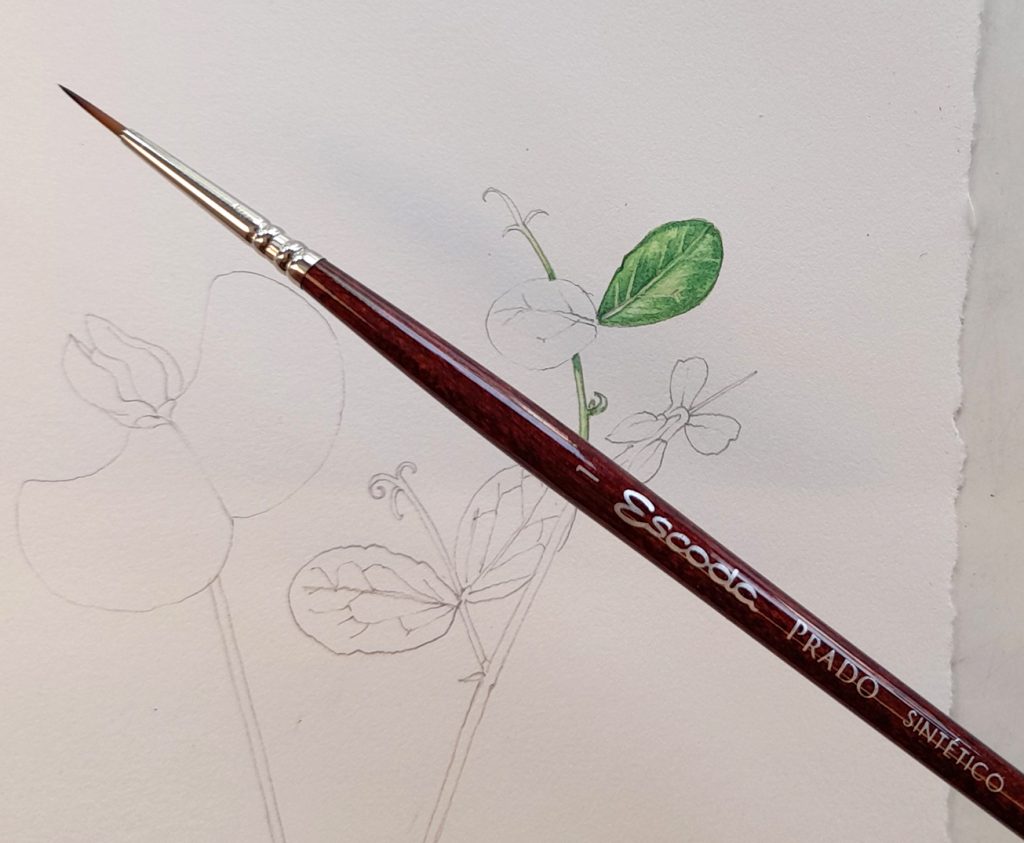
Wet top washes were drama-free, and didn’t swallow up all the white of the page.
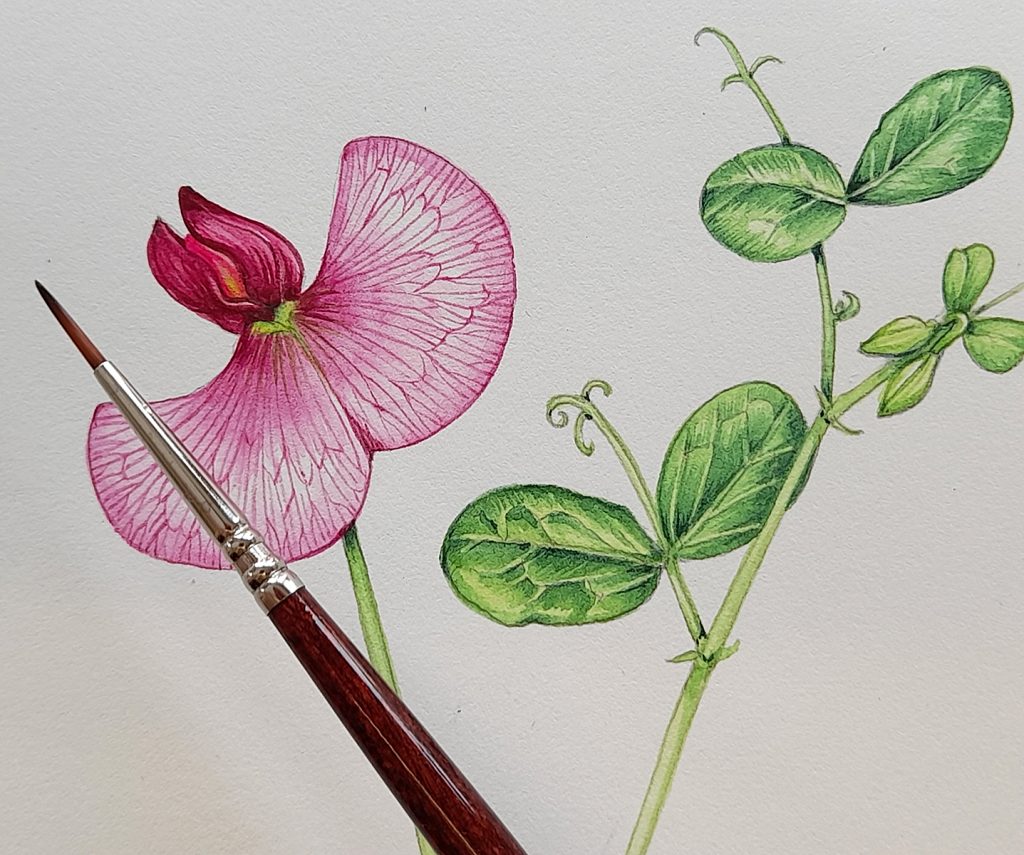
Escoda Prado Tame synthetic: The Blob Test.
Unsurprisingly, the Prado passed with flying colours. The softness of the tip makes it slightly less good at mixing in water during a wash, but that’s looking for things to complain about. Writing its own name was hassle free.
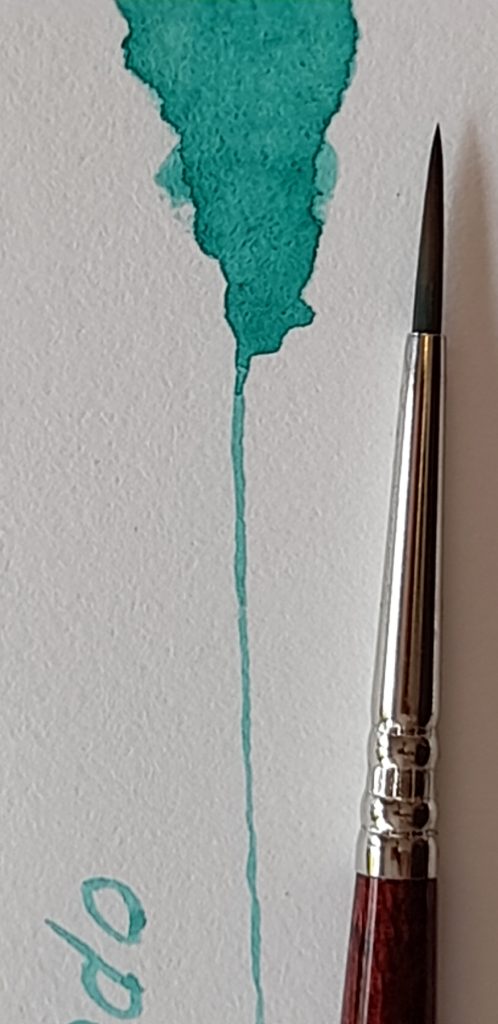
Escoda Prado Tame synthetic: Conclusion
I can’t really fault this brush, except that it’s slightly too soft for my taste. It paints as well as the Neptune, and retains its tip throughout.
This brush currently retails from Jackson’s UK for £6.38
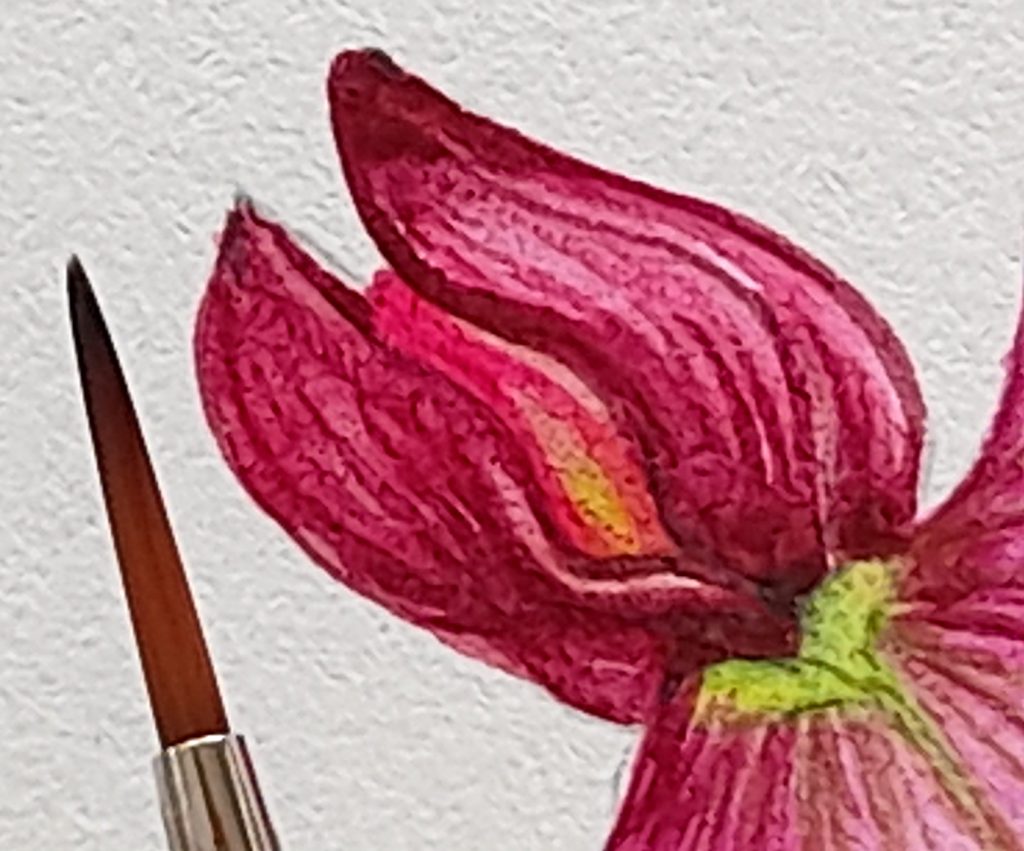
Escoda Perla White Toray synthetic
Perla White Toray synthetic: The new brush
This brush is a number 1 size. On removing the plastic cover, it shows a sharp tip.
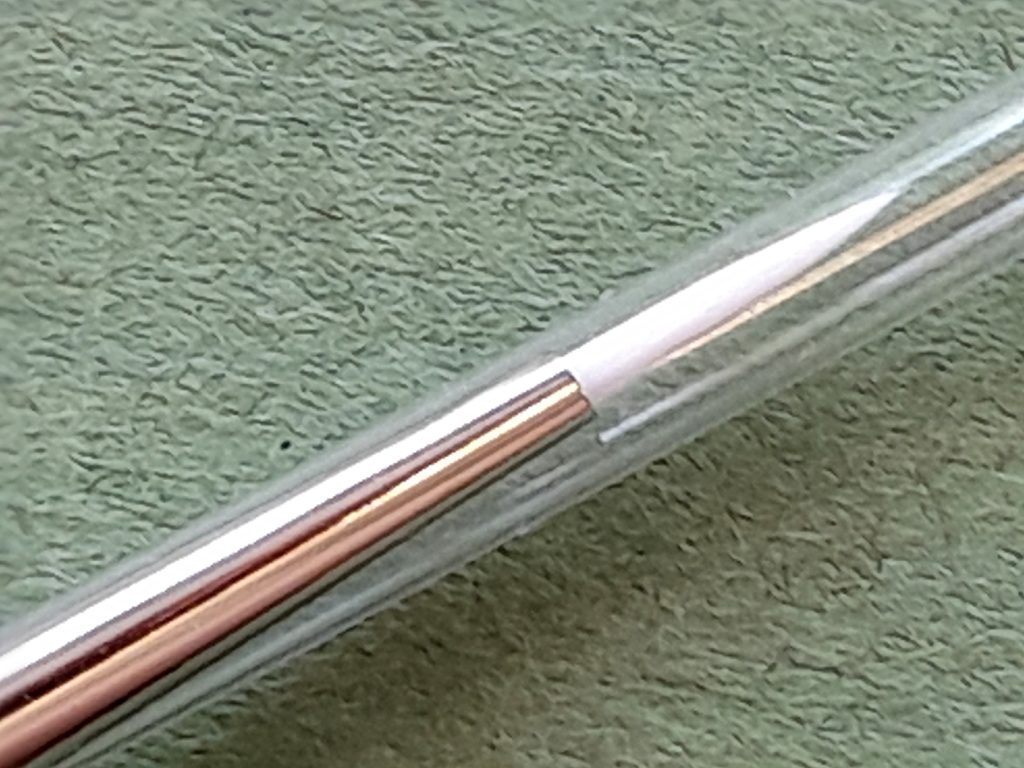
The bristles are pure white which is slightly weird, but within seconds of use they’re stained a comfortable green colour. Phew. It looked slightly too surgical to start with. It’s shiny, normal length handle is grey.
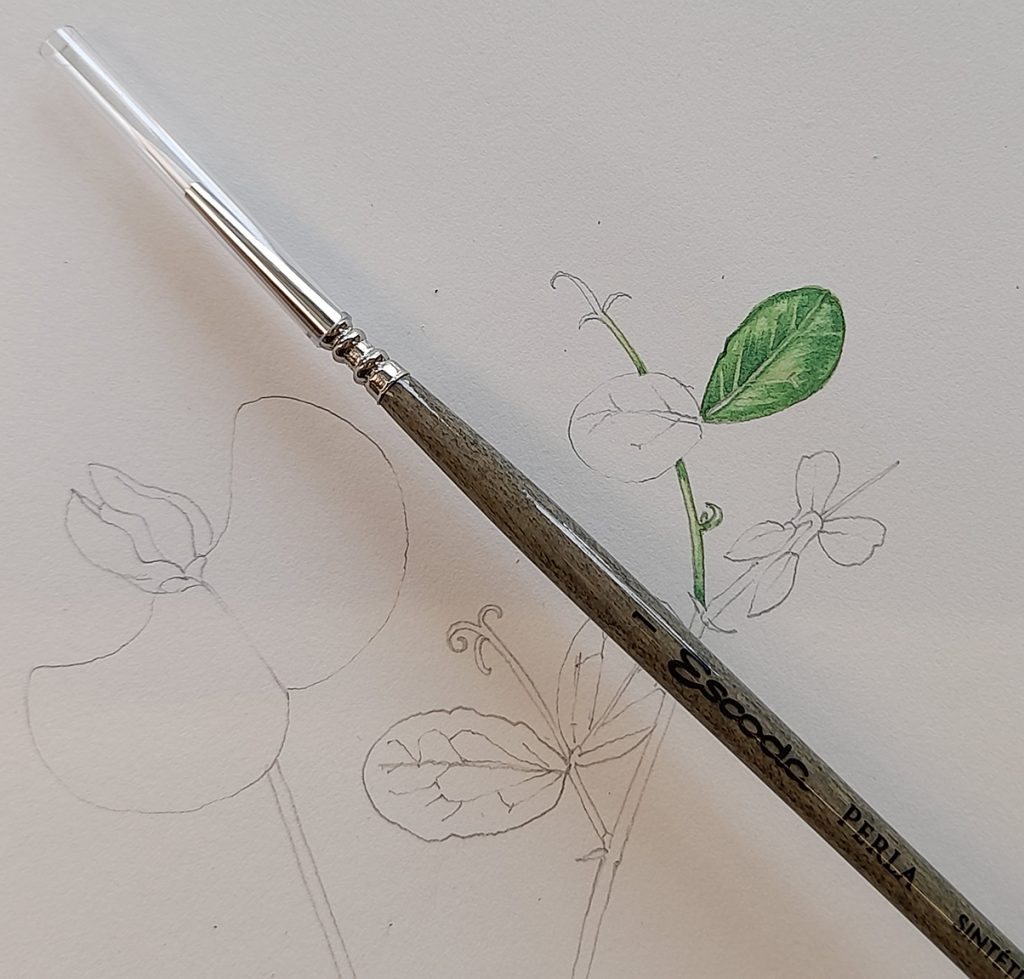
Perla White Toray synthetic: Mixing paint
Mixing is easy, again, with the additional care I’m taking. But the brush doesn’t splay or lose form as soon as it’s put into wet paint. the tip holds firm.
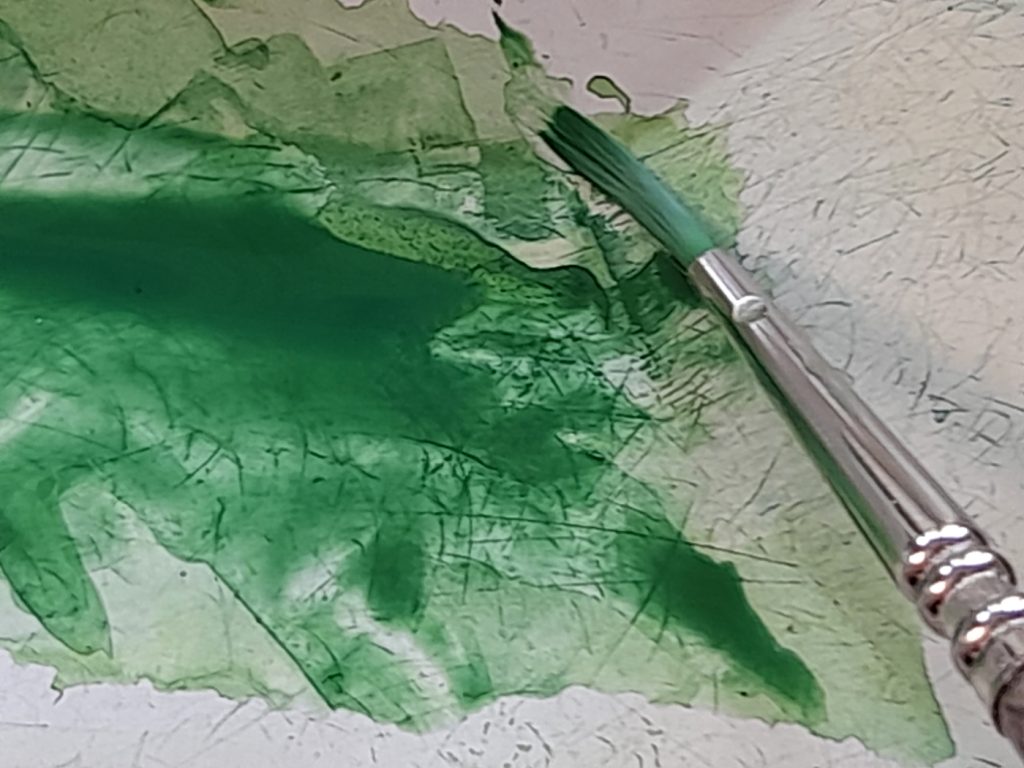
Perla White Toray synthetic: How sharp is that point?
The point is really good. In fact, painting with this brush feels almost identical to painting with the Escoda Prado. Just in a different colour scheme (I can imagine the manufacurers in Barcelona throwing their hands in the air and shouting, “¡No! ¡Ellos no son los mismos!”).
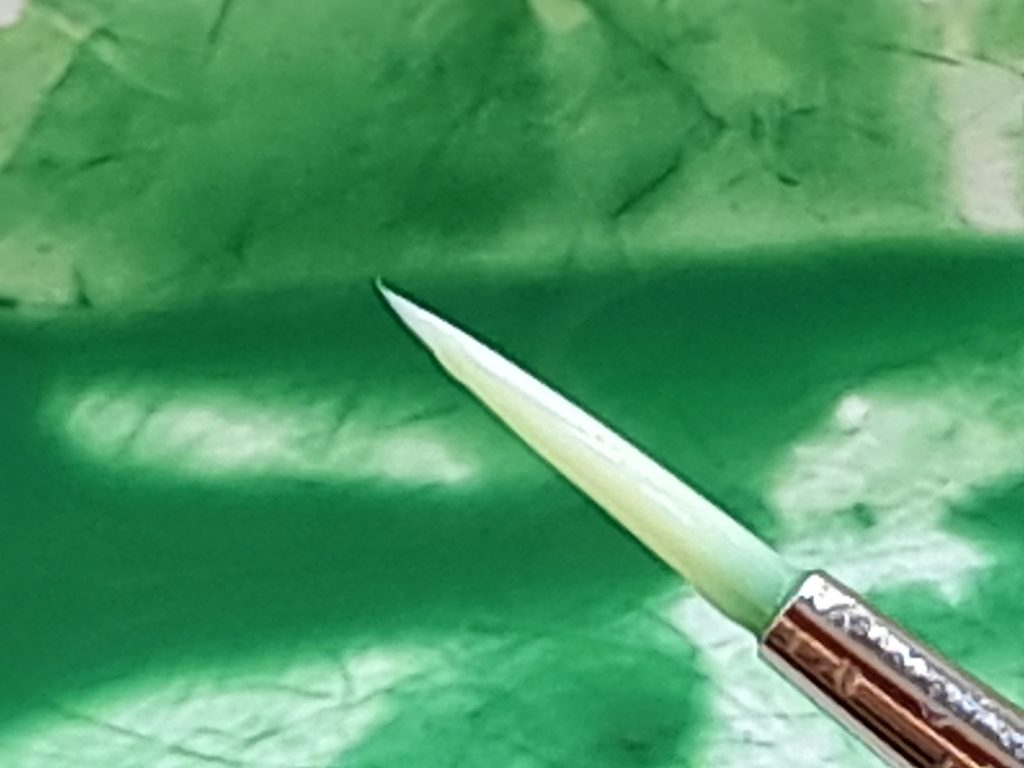
It has that same background soft touch which I don’t love, but which doesn’t compromise the performance of the brush in any way. I think perhaps it has a slightly smaller well than the Prado, so needs topping up from the palette more often.
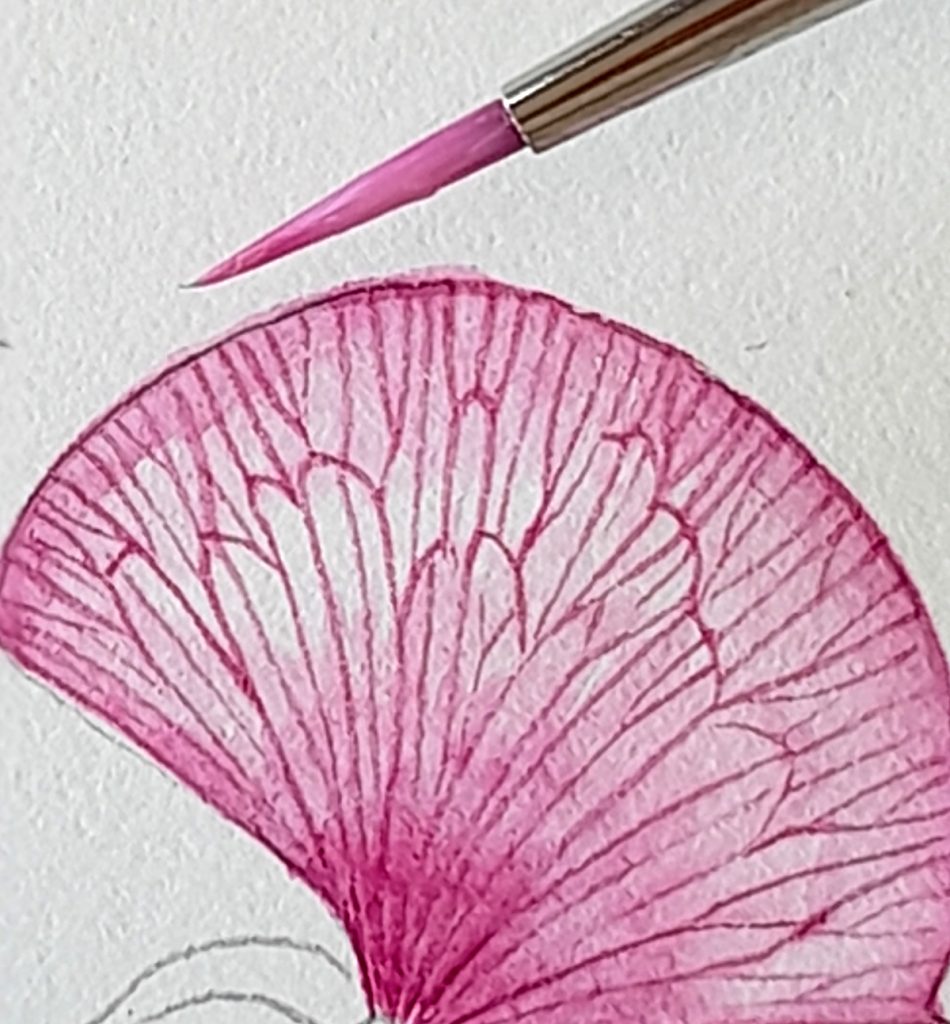
As with the Prado, the top washes went on easily and there was no blobbing or unexpected swallowing up of my white page areas.
By the time I’m done there’s a very slight hook at the tip, but this hasn’t compromised the sharpness of line or accuracy of stroke.
Perla White Toray synthetic: The Blob Test
As with the Prado, the Perla excelled on the blob test, and on being used to write its’ own name. It also has the added benefit of the white bristles picking up whatever pigment is being used, which is a very pretty effect.
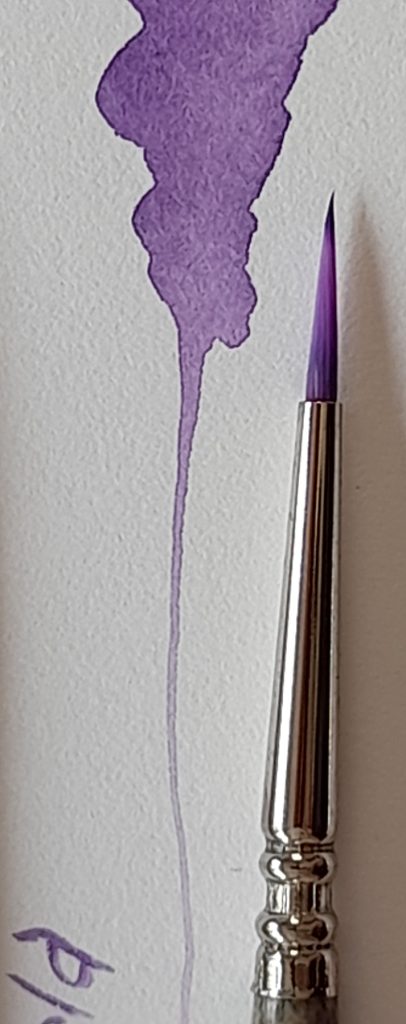
Perla White Toray synthetic: Conclusion
This gets a similarly good review to the Escoda Prado. it worked well and held its tip. It managed detail and washes, and was easy to mix with. It took the right amount of paint from the palette, and at its low price, would have to be a real contender for illustrators on a budget.
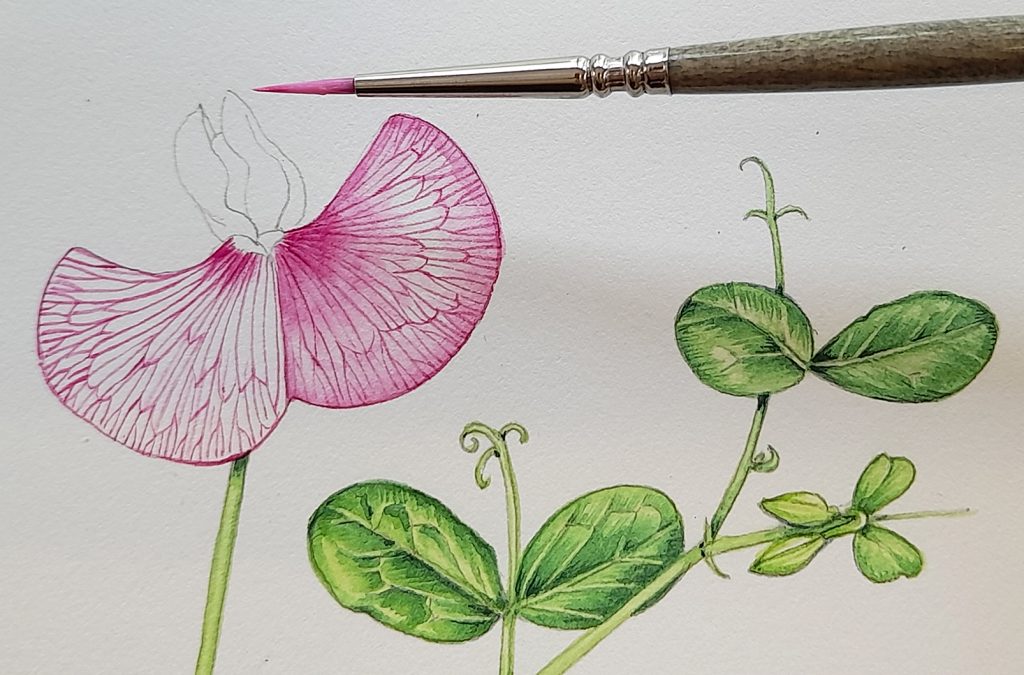
At Jackson’s, this brush currently sells for £4.67
Princeton Velvet touch range
Princeton Velvet touch Round (number 2 as there were no no.1 size available): The new brush
I was really excited about this brush. Having got on so well with the Princeton Neptune, I’m wondering if this could be the next Big Thing.
Taking it out of its’ packaging, the nib looked lovely and crisp. The brush has the look and feel of the Princeton Neptune, although there’s a coating on the brush handle which is very velvety soft. I wonder how differently it’ll behave.
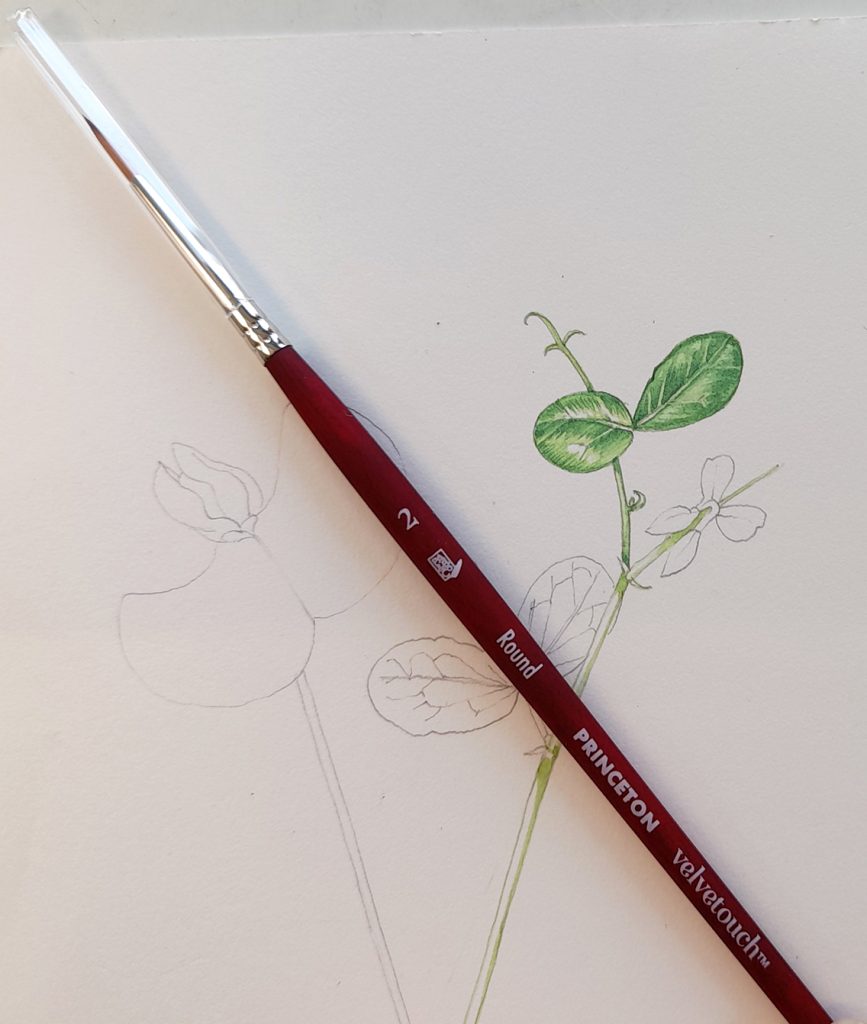
Princeton Velvet touch Round: Mixing paint
When I use the brush to mix paint, it doesn’t lose any of the nib precision. The well is big enough to hold plenty of colour, but not so large it flings it unexpectedly onto the page.
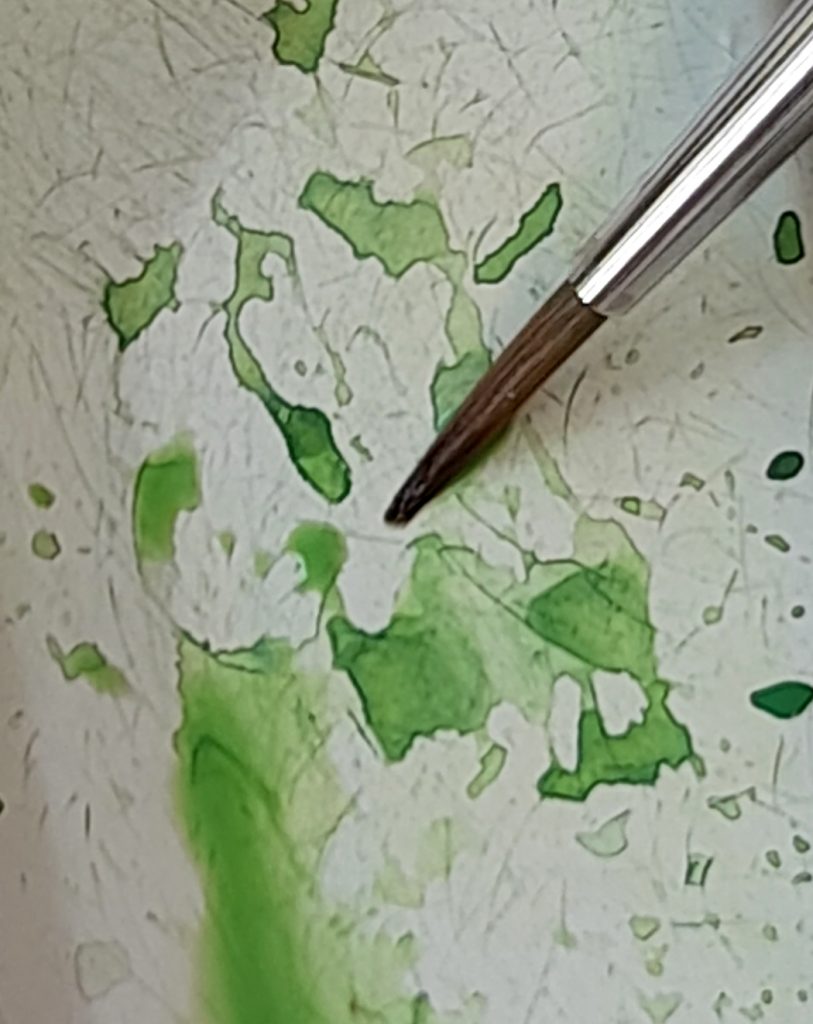
Princeton Velvet touch Round: How sharp is that point?
The point is undeniably sharp. Painting with it feels a great deal like the Princeton Neptune, I’m not sure if I’d be able to tell them apart. I think there may be a little more spring in the fibres of this brush than in the Escoda series, which recommends it to me.
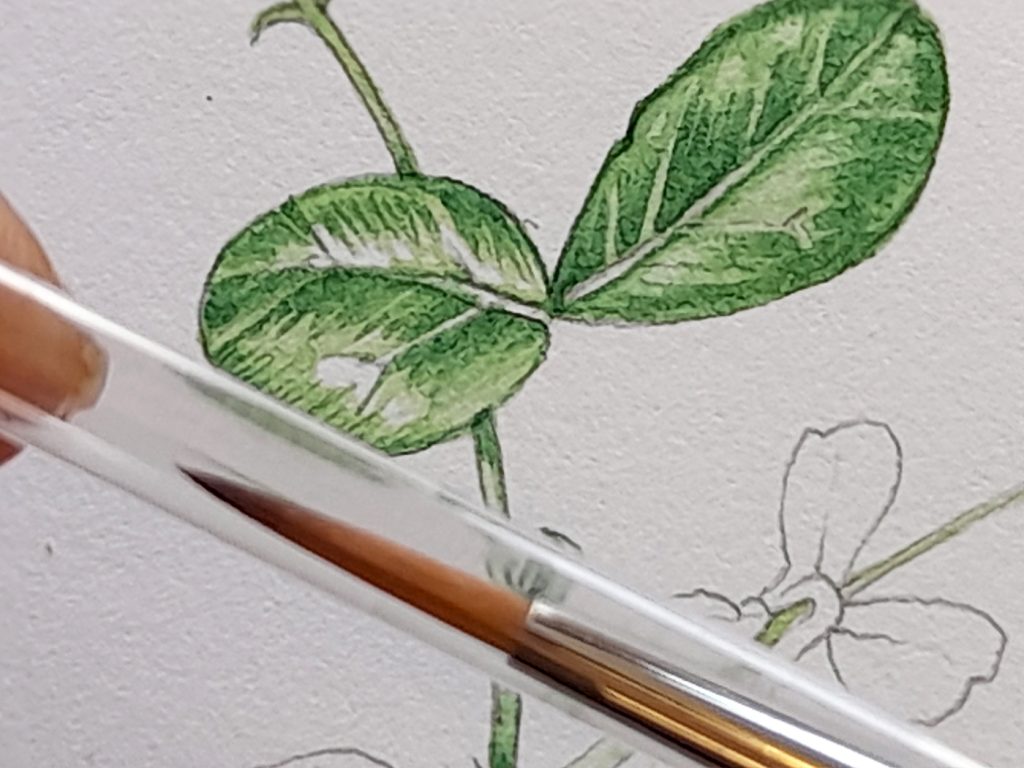
It does crisp lines and outlines, and delivers a steady flow of colour to an accurate tip.
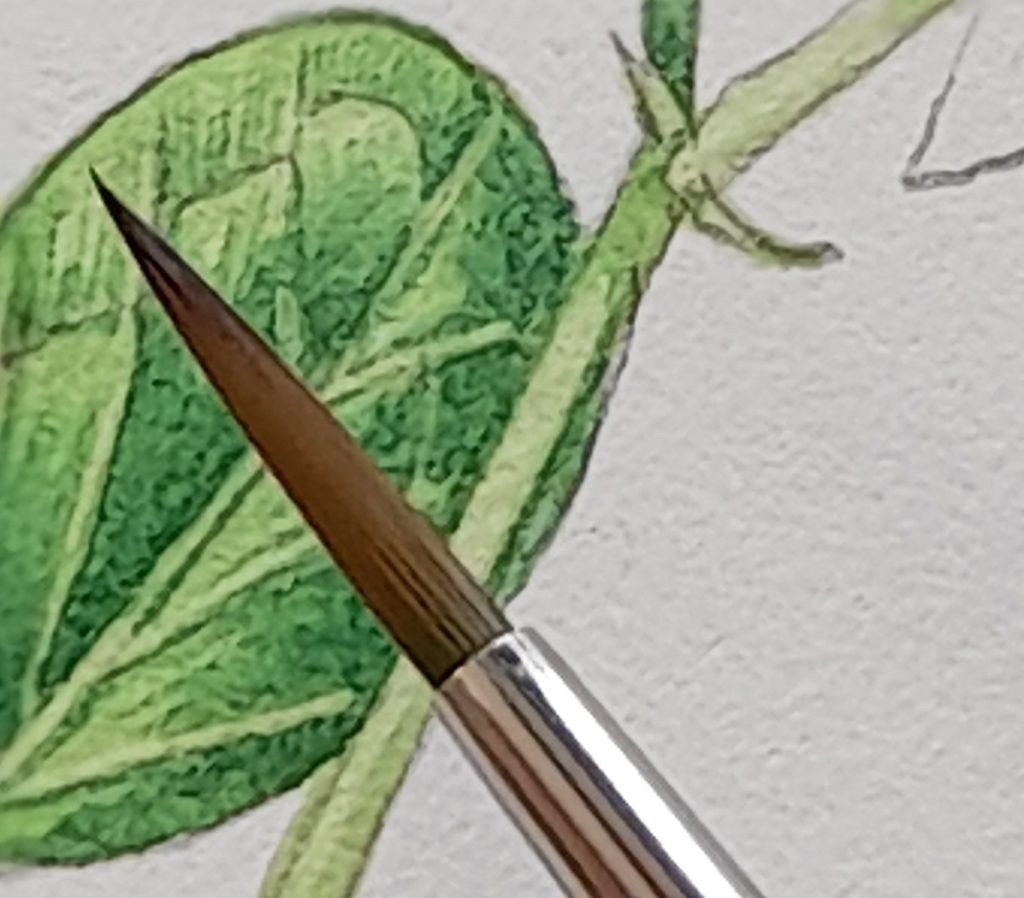
Top washes are equally easy, no unexpected blurring or sudden need to be hyper aware that it’s all about to go wrong. When I had to tweak an edge from another brush (see below), this is the one I picked up.
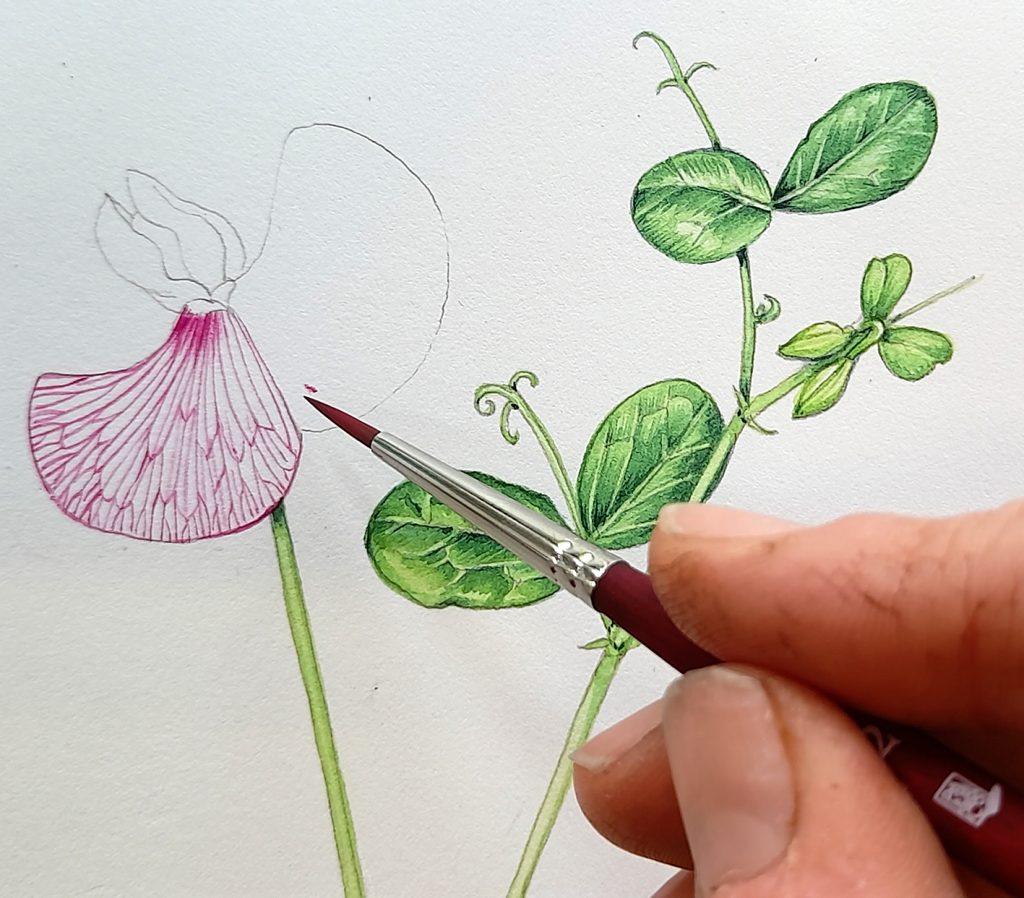
At the end of my test, the tip was still un-hooked and crisp. This means that it, along with the Escoda Prado, are the best of the bunch.
Princeton Velvet touch Round: The Blob Test
Delivery of a nice big blob of colour was easy. Mixing in water was a little swifter than with the Escoda brushes, but we’re talking seconds. The tip held for a sharp single line, and it wrote its own name out beautifully.
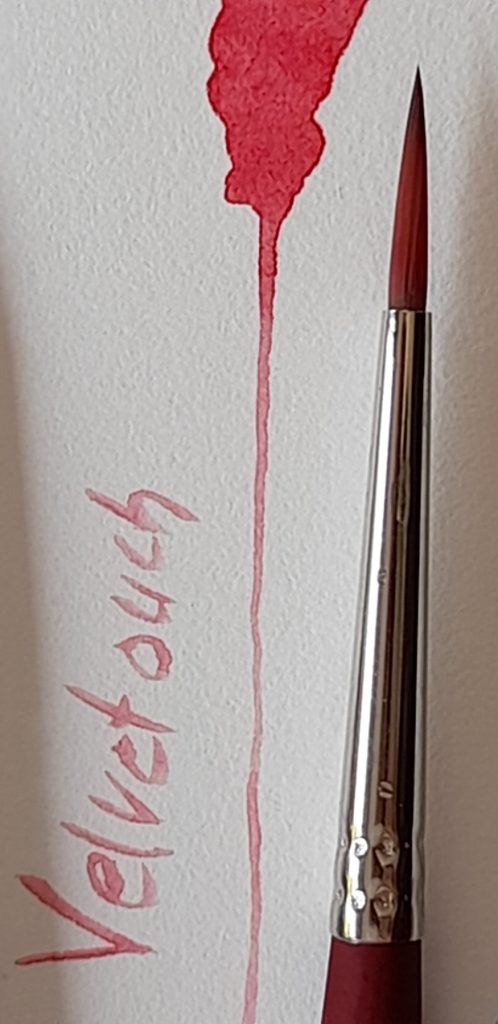
Princeton Velvet touch Round: Conclusion
By the end of the test, I found myself really very pleased with this brush. I’m wondering how to tell the Velvettouch from the Neptune, which will I prefer? So yes, this is another really promising contender.
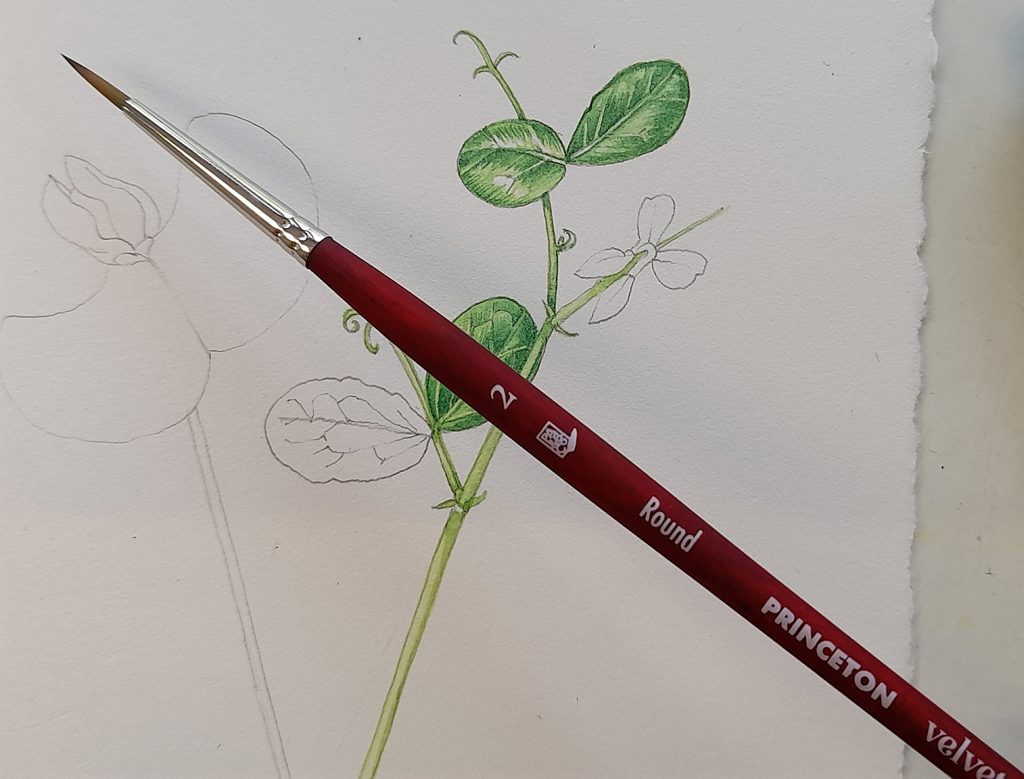
Currently, this brush sells for £4.67 from Jackson’s.
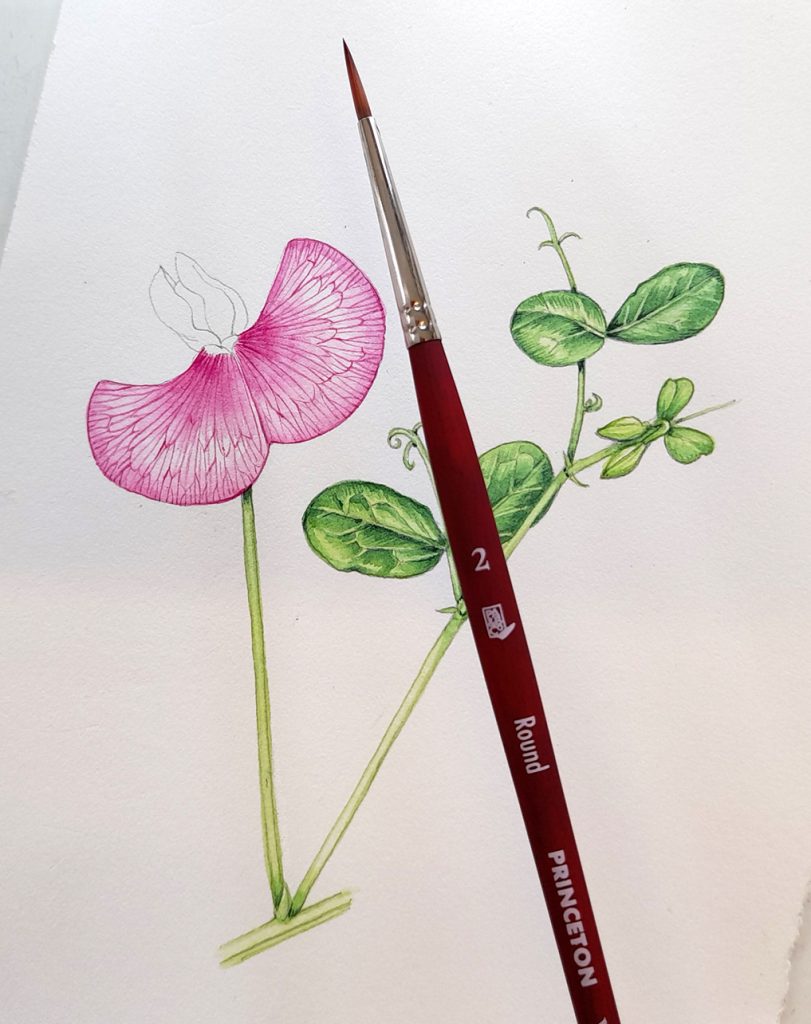
Raphaël Set of 3 Sable Brushes Synthetic Travel #0
Raphaël Synthetic Travel brush: The new brush is part of a set
The new brush looks short, which makes sense as it’s part of a travel set. I couldn’t find a way to buy these brushes individually. Although I’d planned to test the number 1 size, this one looked enormous, rather like the Jackson’s Icon synthetic Quill S777 10/0 which I miserably wrangled with in another test. So I chose to test the size 0.
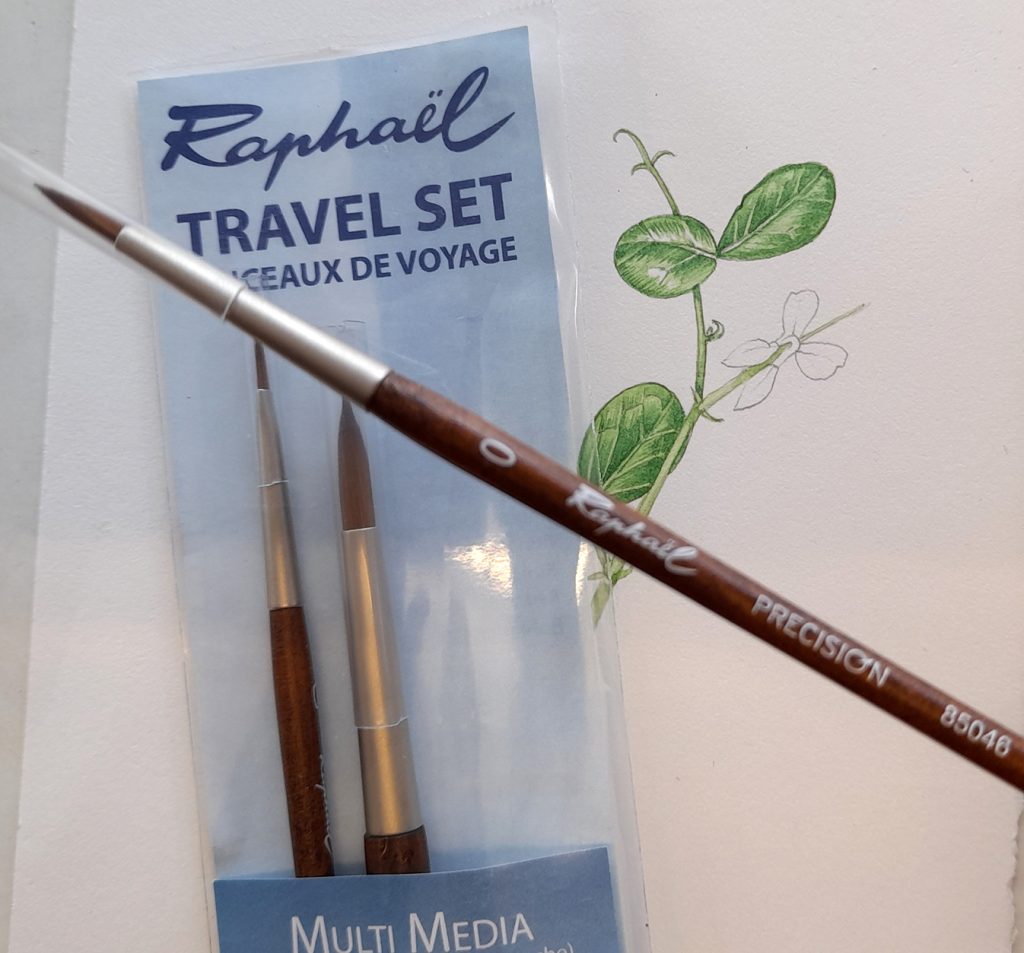
The nib, still within its cover, did not look that sharp, and there was the suggestion of some loose hairs.
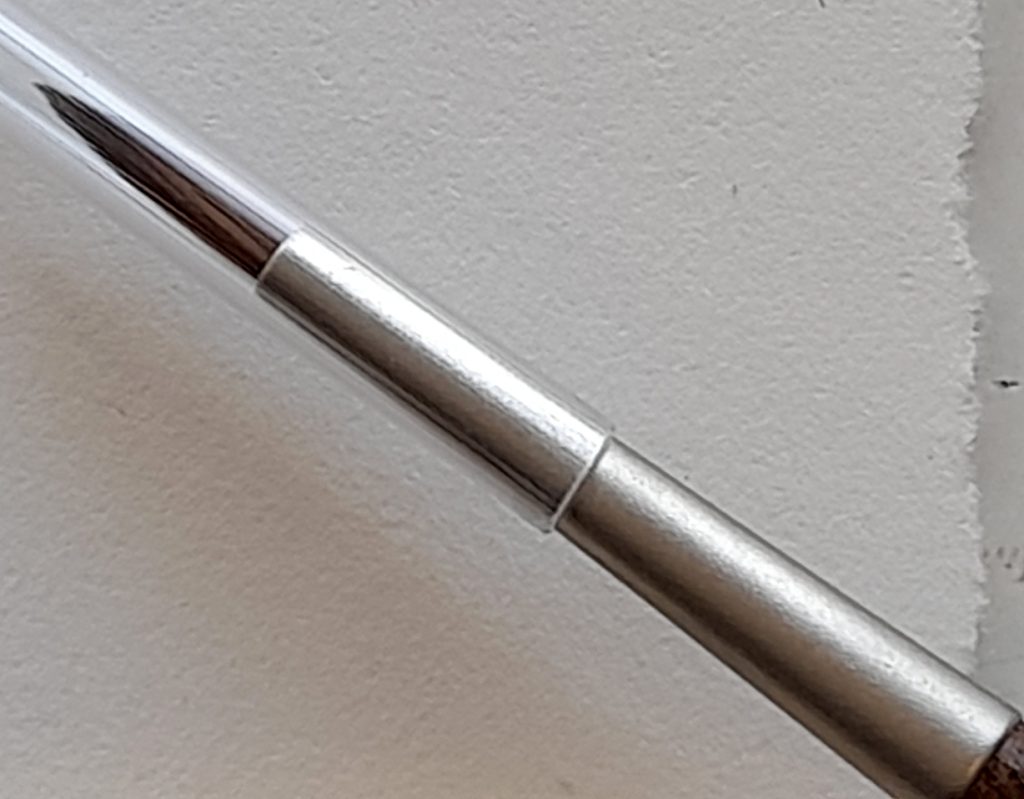
Raphaël Synthetic Travel brush: Mixing paint
Mixing goes fine, again, not mixing but just picking up the paint from the palette. The brush tip looks ever more worryingly blunt, but the well size is good.
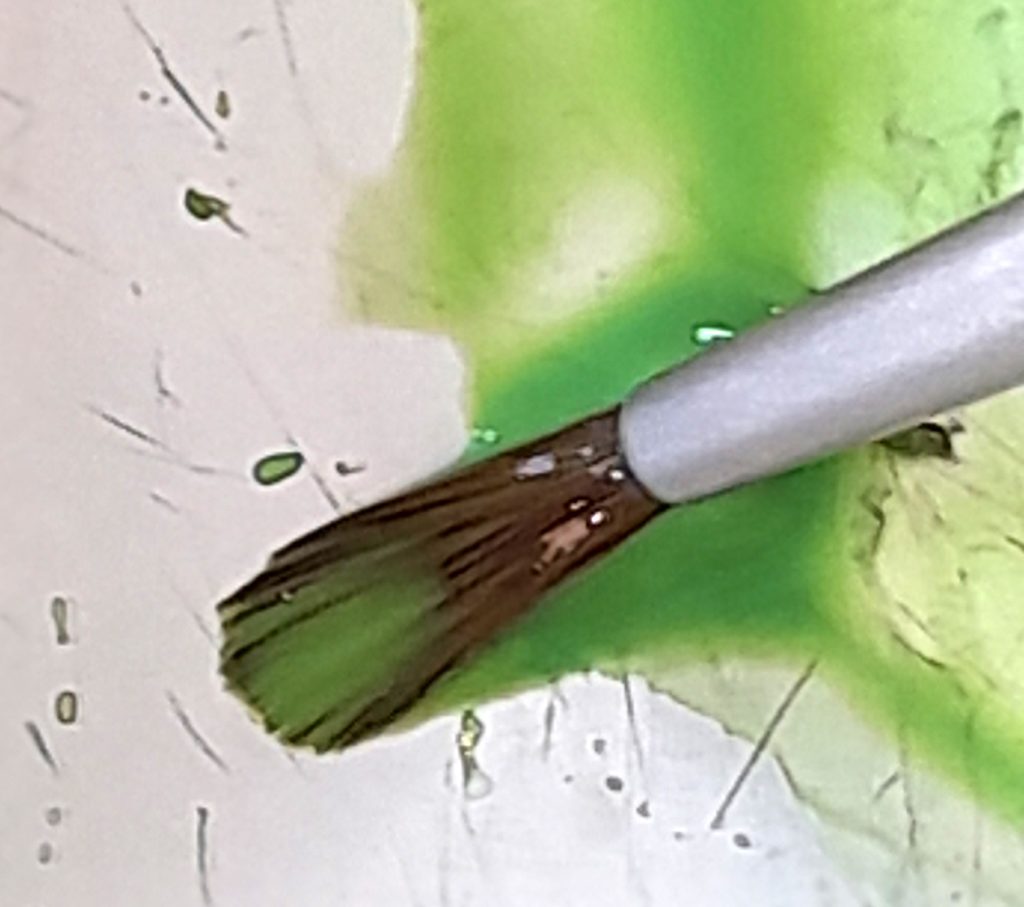
Raphaël Synthetic Travel brush: How sharp is that point?
The Raphaël is disappointing, especially in comparison to the other three, all of which are properly good contenders. The tip is blunt and slightly misaligned. The paint goes on blobbily and I can’t get crisp edges to the leaf.
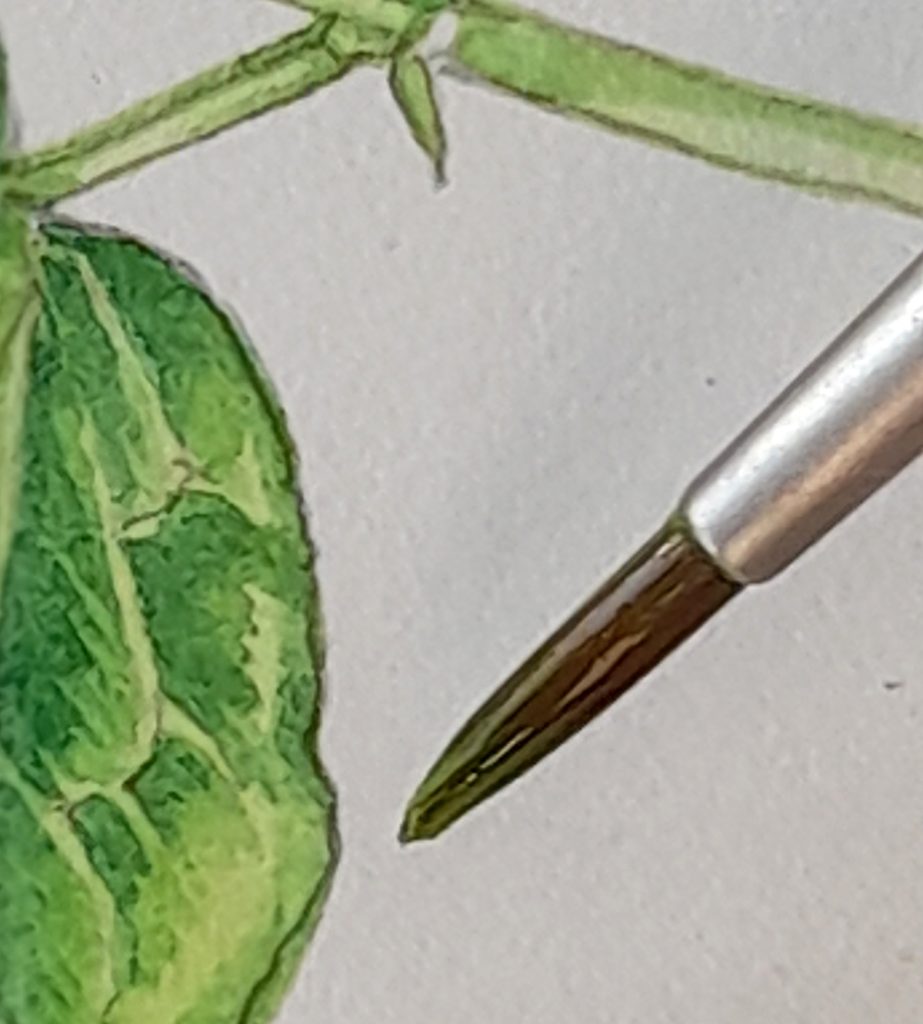
It holds plenty of colour but everything feels a bit desperate and blunt, I don’t enjoy painting with this brush.
Raphaël Synthetic Travel brush: The Blob Test
The blob test showed the rather stark difference between this little brush and the other three tested today. the nib was scratchy and couldnt hold a point, yes it carried enough paint and water to the blob, but the attempt at a straight line was not a success. Writing out its’ own name was equally challenging.
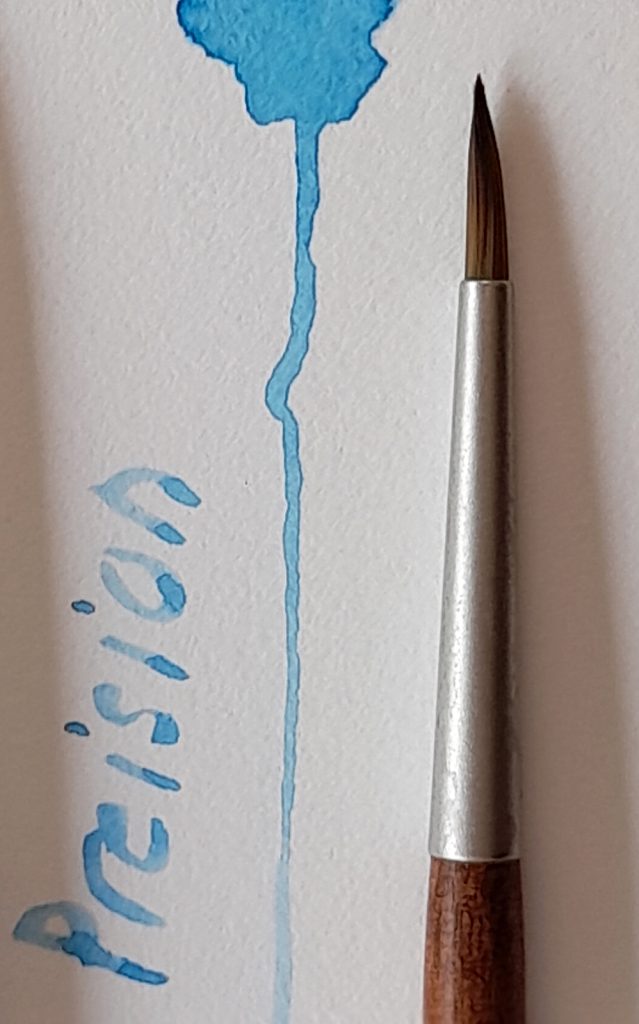
Raphaël Synthetic Travel brush: Conclusion
This brush did not impress, I’m afraid. It was too short in the handle and the tip was blunt and a little scratchy. The point was sort of ok, but the well was too big for it, and kept overflowing unexpectedly onto the page. When it came to working on the Sweet pea flower I didn’t even bother trying this brush as I already knew it wasn’t up to the precise nature of the job in hand.
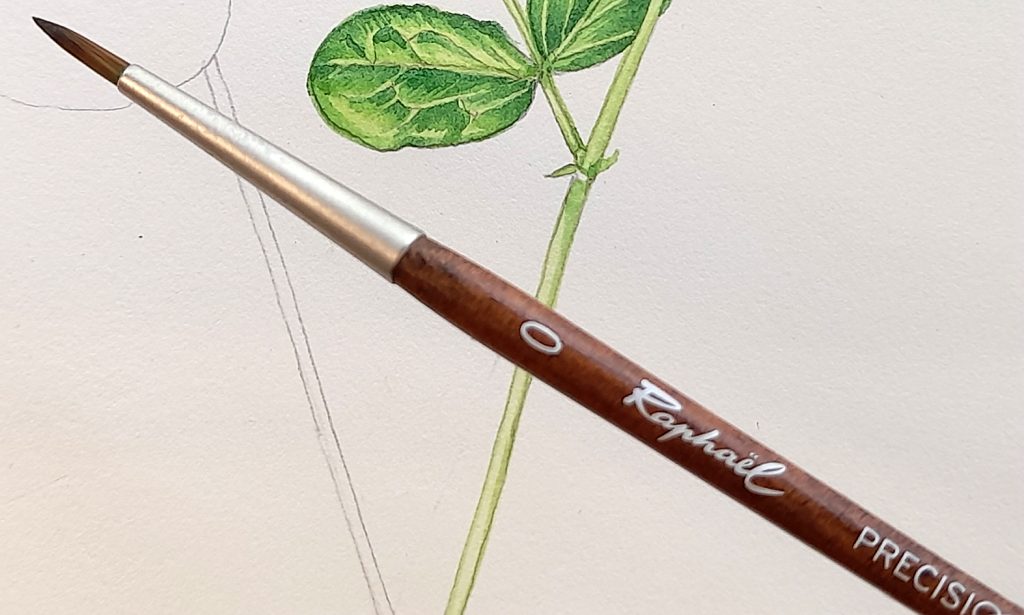
This brush is currently selling at £10.05 for a set of three (size 1 round, size 0 round and a Flat size 0) from the Craftelier.
Conclusion
So four brushes were tested. The Escoda Prado Tame synthetic was really good. It held its’ tip and carried paint well. For my taste the bristles were a little soft, but that really is splitting hairs (what an appropriate turn of phrase!) Certainly, this brush is a contender as a synthetic replacement. The Escoda Perla White Toray synthetic was similarly excellent, and even the slight hooking of the tip didn’t seem to compromise the brush’s accuracy. Again, there’s that slight softness. but personally I enjoyed working with it, and think I’d be unable to tell the difference between the two Escodas tested. Both are contenders. The Princeton Velvet touch range was my favourite, and left me very excited. Accuracy, a slight stiffness, and a soft touch to the handle. I really like it and think it just might have knocked its’ brother, the Princeton Neptune, off the number 1 spot. I will certainly be buying more of these. The last one, the Raphaël synthetic sable (no. 1) was disappointing. In amongst this field, it didn’t stand a chance. No tip, and a lack of accuracy that I can’t live with.
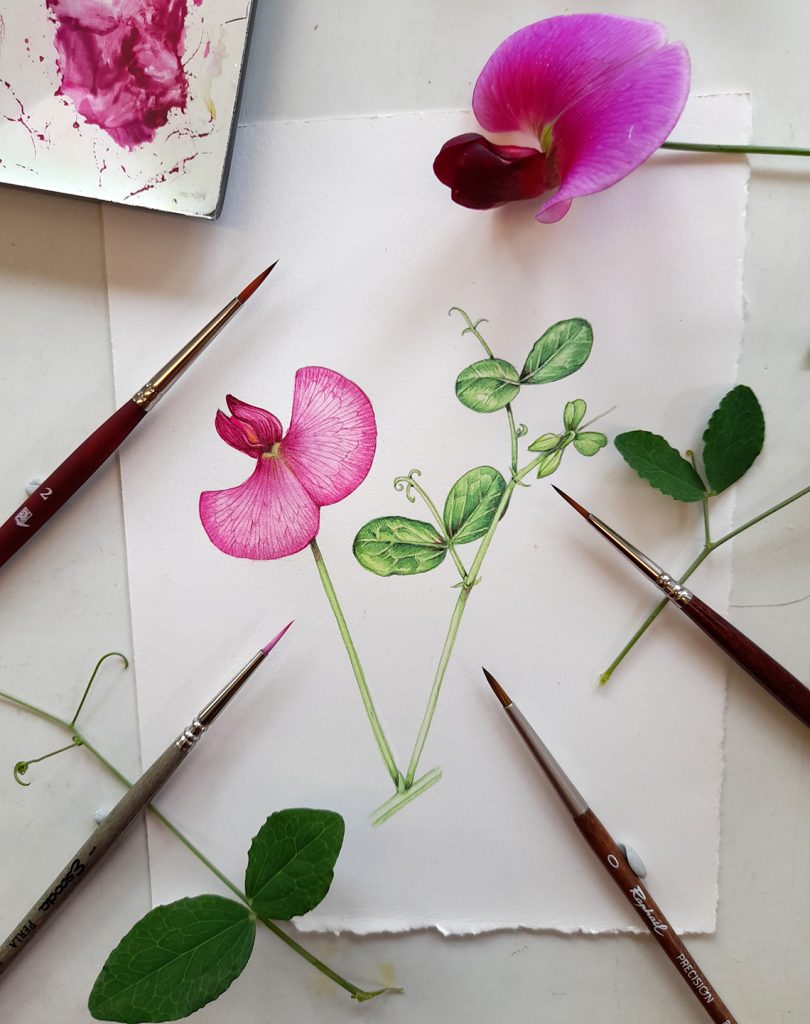
For me, both Escodas and the Velvetouch are worth using again. I’ll use them for a while and see which becomes my favourite, and add the Princeton Neptune to the mix. Could these be a replacement for my normal Series 7? It’s looking very promising, but only time will tell.
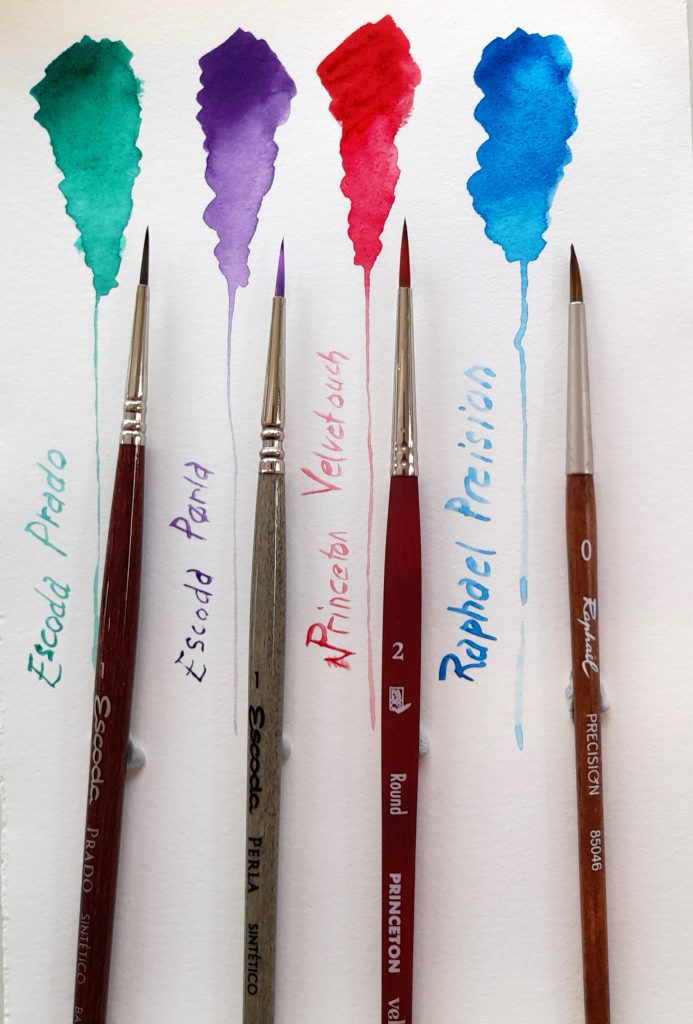
Take-home messages from all my Synthetic Brushes tests
So here we are, having tested 20 synthetic brushes. This is the end of the line for me, and I’m glad to say there are some really helpful take home messages. Look out for hooked tips (for tips on fixing these see below). Don’t be fooled into thinking that because it’s cheap it will be rubbish. Many of these had similar performances despite prices varying from £2 to £12. Be aware of your biases and existing preferences which may be really tough to overcome. A synthetic will never feel like sable, and we shouldn’t expect it to. Remember these choices are really personal and my favourite brushes may not be other people’s favourites.

Synthetic Brush tests: The Winners!
At the end of several years and 20 brushes tested, and over £100 spent, there are three clear winners:
1. Joint first place goes to Princeton Neptune round and the Princeton Velvet touch range which I’ve been painting with and enjoying. Not quite as good as my Series 7, but only a whisker away. I’m yet to decide which I like more.
2. Joint second goes to the Escoda family – Escoda Prado and Escoda Perla. Both are admirable and kept their tips, and painted consistently accurately and well. My only slight problem was that they felt a touch soft for my taste, but that truly is down to personal preference. Really decent synthetic brushes, and no, I can’t tell them apart on performance.
3. Thirs place goes to Rosemary and Co. Spotter Red Dot, although the blunt tips of some of their other brushes makes me wonder if I’ll be using it long-term
4. Honourable mention is for Billie Showell Fineliner. If I were a better person and used to using riggers, this would doubtless be even more successful. Great for extremely confident and exceptionally thin lines, and designed for detailing not body colour.
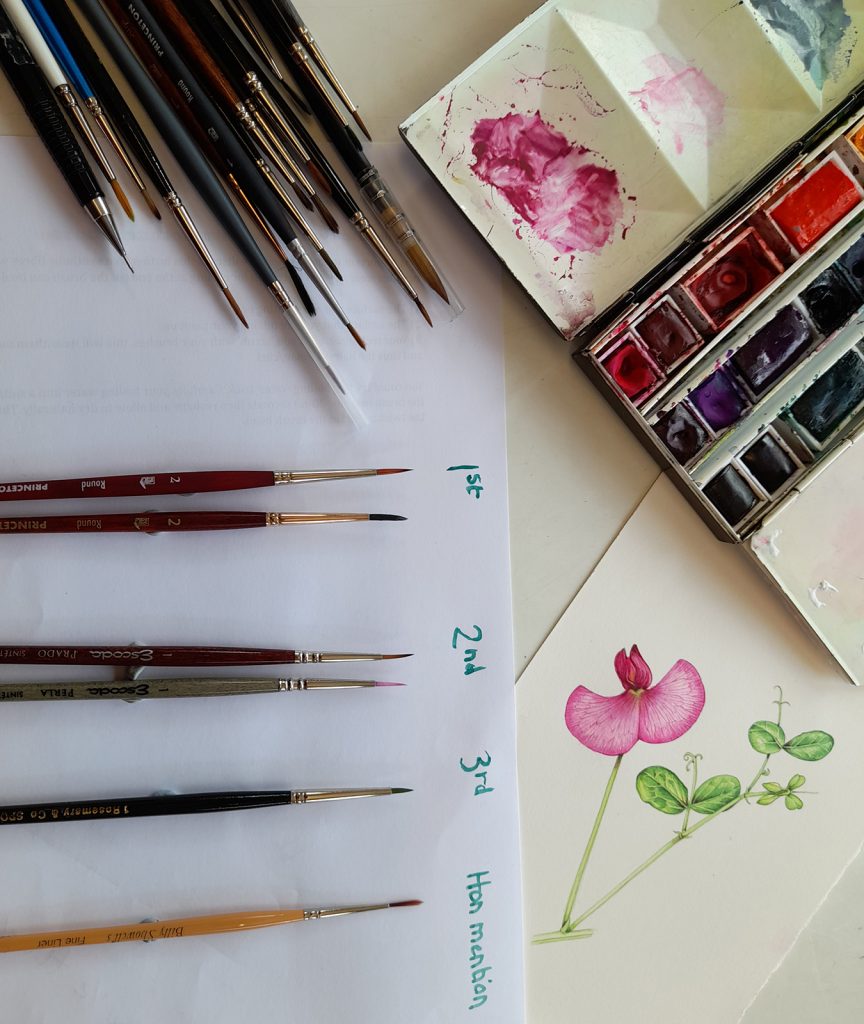
So all that remains is for me to give you a massive thank-you for sticking with me through this process! I can only hope some of it has been of use to other artists and illustrators, faced with a similar dilemmas. Thanks so much for reading, watching, and suggesting alternatives. I couldn’t have done it without your input.
Brush Suggestions I won’t be trialling
Below is a list of suggested brushes that I won’t be testing for various reasons:
The first lot I’m not testing as they are sable, sable mix, or squirrel: Rosemary & Co Series 402 pointed (Sable plus synthetics mix), DaVinci Maestro series 35 (Sable), Escoda Chronos (Synthetic plus sable mix), and Neef Needlepoint ( Squirrel)
The Princeton Elite has too long of a tip for me, and I’ve learned that I don’t like long-tipped brushes!
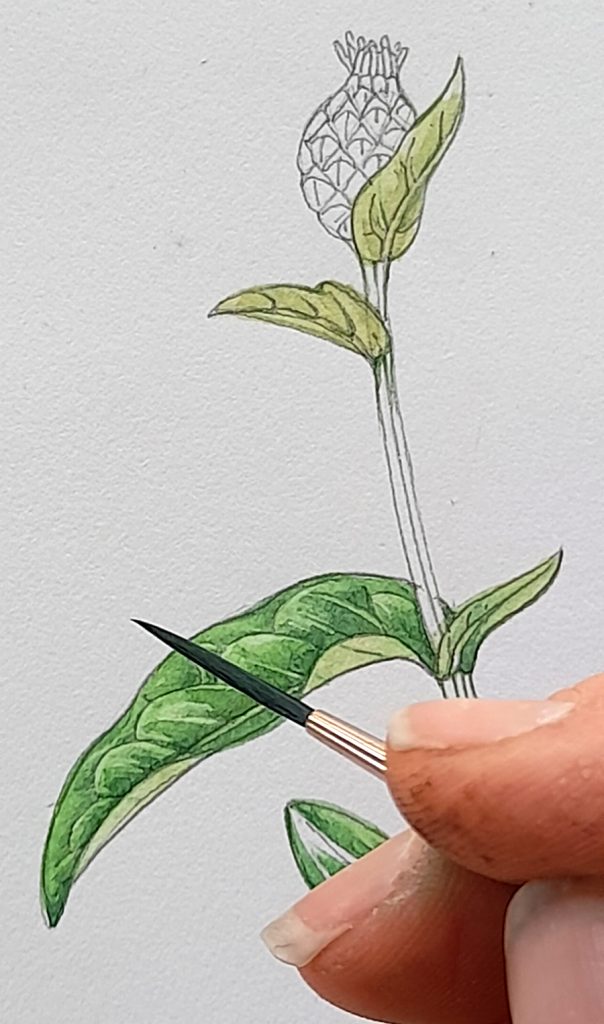
And the following brushes are either not available to order in the UK, or are available from Europe but with really high import prices. Apologies, I don’t have links to them as I can’t readily source them here:
Princeton Heritage Round, ProArte Prolene plus, Perla brushes Princeton, and Princeton Heritage 4050 (which may be the same as the Princeton Heritage round range).
And now (thank heavens) I am DONE!
Here is the film showing the last set of synthetics being tested:
!!YOUTUBE LINK!!
Synthetic brushes: A hint to help fix hooked tips
Worth repeating from my other blogs, this tip has come in from Rebecca. She kindly left this suggestion on fixing bent tips of synthetics in the comments section. (It echoes the advice on sorting out hooked tips from the Rosemary & Co website). “Hooks that develop on synthetic bristles can often be remedied by dipping the bristles about half way into a cup of water taken off the boil. Take care not to get the ferrule or upper bristles wet with water this hot or it may affect the glue. The timing varies from 10-30 seconds based on the brand and size. Gently reshape the tip on your thumbnail after heating. While I don’t expect that is an annoyance one would want to deal with during a long painting session, it will at least restore the brush to a usable condition for lighter tasks.”

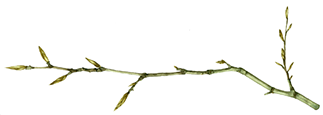
Hi! Great and detailed review, thank you very much. I have a tip, if you want to get a few more uses out of your hooked brushes, you can repair the tip by dipping it into hot water (tea kinda temperature) for 2-3 seconds and shape the tip with your fingers. I’ve been doing it for about 10 years to both natural and synthetic brushes, it doesn’t do any damage and returns the crisp tip to get a few more uses from an old brush. I’ve done it to the same brush many times as well
Thanks Eve, that’s a great tip. I think you’re right, the hot water relaxes the hairs I think so thay can be tweaked back into a fine tip. Thanks for sharing this!
This was very helpful. I’m excited to explore some of the brushes you have tried. Thank you.
So glad top help, Jeff!
I have used Lineo Brushes for a long time now. They have both synthetic, savle and squirrel hair brushes, and their kolinsky sables are very nice, but probably not Series 7 quality. They do hold up nicely though.
I have several dotters from them too, and use their synthetics for a long time in small sizes.
Will have to look into Escoda and Princeton though! They sound nice!
Oooh thanks for this. Lineo. Ill give them a go next time I need to re-stock.
Hi Lizzie, I have loved this detailed review. Before I order any similar, can I check please, are any of them miniature brushes, including the W&N series 7? Your work is so fine I wondered if you use miniatures.
Many thanks for your lovely posts, Diana
This in interesting cause I recently bought miniature series 7s by mistake, not normal series 7. And I HATE them! The nibs are teeny so don’t hold onto much paint. I’m such an old woman, stuck in my ways and fervently attached to one brand of brush. But I know other illustrators much prefer the miniature ones. Both cost a small fortune though, so it’s not easy to do a compare and contrast!